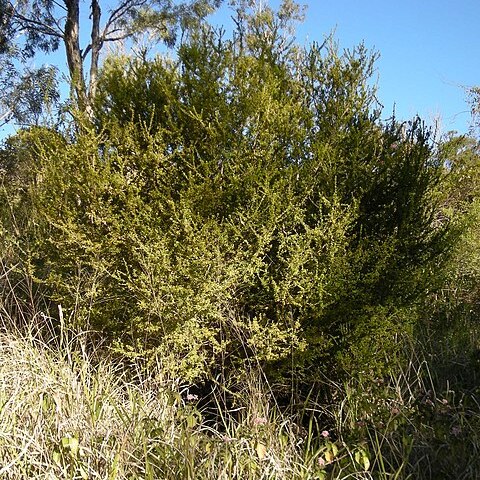Rigid shrub or small tree to 8 m high; short shoots spinescent in most developmental stages but less frequent in adult stages; new shoots densely hairy with triangle-based, T-shaped hairs with long ribbony arms; stems then scabrid with persistent hair bases, eventually becoming smooth, white to pale grey. Cotyledons 2, narrowly elliptic, apex acute with mucro. Seedling leaves almost apically tri-lobed; juvenile stages with slender spines 6–8 mm long subtending leaves from first internode. Adult leaves clustered in groups of up to eight, stem-clasping, thick, coriaceous; spathulate to broad obovate, 8–15 mm long, 5–6 mm wide, winged to base; apices entire; leaves glabrous, adaxial surface green, abaxial with waxy pellucid spotting. Flowers are mainly solitary, parts in fives surrounding the pistil; peduncles thick, ridged, very bracteose. Sepals either briefly cohering at the base and then spreading, or remaining connate to nearly 2/3 length then recurved, apices acute; petals cohering to 4/5 of length and then recurved salverform, 8–10 mm long, white. Insufficient flowering material seen to determine if flowers are bisexual, unisexual or both. Stamens with filaments slightly adnate to petal joins, unequal and apparently at three different heights; anthers golden, ovoid with rounded apices. Staminate or male phase flowers have exserted golden anthers, pollen dehiscing at petal break; the pistil prominently stipitate with a basal nectary, the ovary slender, shorter than the style with no stigmatic development. Pistillate or female phase flowers have a prominent gynophore and basal nectary; on a wide receptacle, the ovary is plump/rotund thick-walled; with 5 thin ribbony placentas (3 in New Guinea) flush on the ovary walls, not raised, giving the ovary the appearance of being unilocular. The capitate stigma in these flowers is generally exserted past the level of the anthers, and in some flowers stamens/staminodes barely reached to the base of the style. Fruits are capsule-like but indehiscent, globose, large: 20–25 mm diam., thick-walled (to 3 mm), green, eventually black-brown and persisting on the plant. Seeds light brown, copious (60–100), inserted horizontally in two rows in each loculus, almost hemispherical, thickened margins, sticky with thick resin.
More
A shrub or small tree. It grows 5 m tall. The branches are slender and spiny. The leaves are small and less than 2 cm long. The leaf shape varies. The flowers are small. The fruit are green to brown and hairy. They are 2.5 cm across. The seeds are small and in a sticky pulp.
This is a dry country shrub or small tree, never common and occurring on a variety of soil types including ultramafic (serpentine), limestone and basalt, in lower altitude monsoon forest, vine thickets and drier seasonal rainforests.
More
It is a tropical plant. It grows near rivers and the coast. It grows from sea level to 1,200 m above sea level.
Dry sclerophyll forest, dry rainforest and closed scrub.

